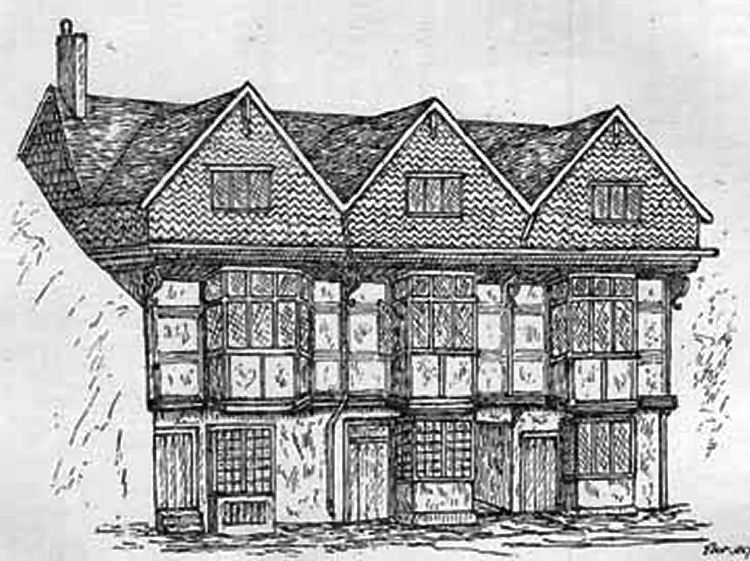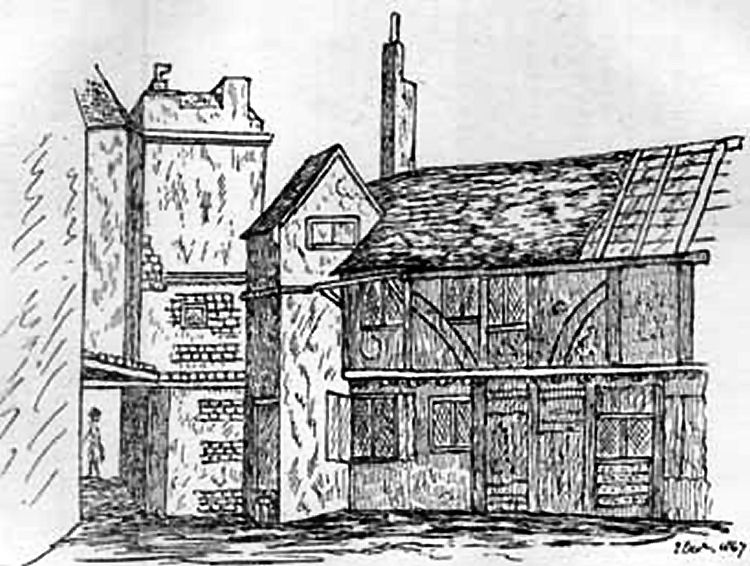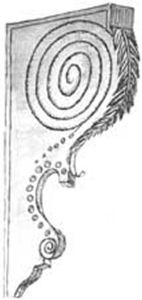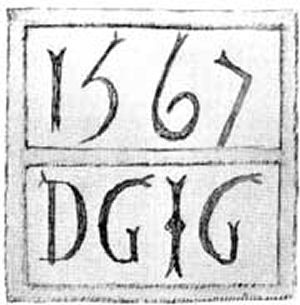|
From the Kentish Chronicle, 4 August, 1860.
A CHILD DISCOVERED IN A DRAIN NEAR THE NEW ROAD.
On Friday morning about two o’clock, a man named Davison, a vendor of
water-cresses, wan near Mr. Collard’s hop garden, when he heard a sound
as if of a kitten crying, in the direction of the drain, which runs down
the road.
On his return about seven o'clock with his cresses, he heard the same
noise, and on proceeding to the drain cleared away the mouth and
inserted his arm, when he brought forth a female infant apparently about
two months old; it was naked and cold—the bottom of the drain being
muddy. It had a piece of tape tied tightly round its neck, which on
being removed left a mark: the would-be murderer had doubtless intended
to strangle it. Davison took the poor little infant to the
Police-station, where it was attended upon by Mrs. Davis, the wife of
the superintendent, under whose kind treatment it gradually recovered.
In the course of the morning it was taken to the Union.
The police have since ascertained that a young woman, with a baby, slept
at the "Star," Coffee House, St. Dunstan’s on Sunday night last, and Mr.
Blackman’s daughter said that she should know the child again, by a mark
which it had on its head. It was fed from a bottle. On Miss Blackman's
arrival at the Union, she identified the child, pointed out the mark on
its head, and one of the women at the Union placing the child to her
breast, it refused, but readily took a bottle, this completely
corroborated Miss Blackman's statement. The woman was traced as having
slept at the "Monarch," in Stour-street, on Wednesday night. Mr. Omer,
the landlord, observed in her arms, when he thought was a bundle, but
which, on her going to bed, he saw was a child. Mr. Omer also saw her in
Broad street, on Thursday evening, with the child. She is described as
being showily dressed, and rather good-looking. There is not the
slightest doubt, but that she will be shortly in the hands of the
police, having obtained this clue to her.
DEATH OF THE CHILD.
Notwithstanding the care and attention bestowed on the little sufferer,
its system had received such it shock that it expired last evening. An
inquest will be held today (Saturday)
Up to the hour of going to press the perpetrator or this unnatural act
has not been discovered. The police are using every exertion, and before
long it is hoped their efforts will be crowned with success. It is
wonderful that the child should have survived so long; as it must have
been in the drain six or seven hours, with a string tightly round its
neck.
THE CHILD MURDER.
On Saturday last an inquest was opened on the body of the child, found
in the drain in the New Road, at the "Cross Keys" public-house, before
T. T. Delasaux, Esq., and a respectable jury of which Mr. Gillman was
foreman. The coroner having briefly stated the circumstances which had
given rise to the inquiry, the jury proceeded to view the body, after
which the following evidence was adduced.
Mrs. Harris, wife of a labourer, o being sworn, deposed:- Yesterday
morning, between the hours of eight and nine I went to the
police-station.
I there found a child in the arms of a man. I took the child and shortly
afterward put it in a warm bath; it apparently partially recovered, and
it was afterwards taken to the Union Workhouse. It died at half-past
three on the afternoon of yesterday. I did not know to whom the child
belonged. There was a small mark on the left side of the head. I took a
piece of tape from the neck of the deceased, which had been tied very
tight and fastened behind. It was crossed on the chest and tied round
the waist.
The inquest was then adjourned till Tuesday, in order to give the police
time for further inquiries.
On Tuesday the coroner and jury again assembled at the house of Mr.
Wison, "Cross Keys," St. Sepulehre's, when the following evidence was
adduced:-
Robert Davison and Samuel Carter, labourers, jointly stated that they on
the morning of Friday last were on the Dover road, on their way to
bridge, going to gather water cresses, and on reaching the hop grounds a
short distance from the turnpike they heard, as they then thought, the
whining of a dog in the drain which passes from the road under the
footway into the hop ground; it was dark at the time, being then about
two o'clock. They returned to Canterbury the same morning, and between
seven and eight o'clock reached the same spot, and were induced to look
into the drain in order to ascertain what the noise they had heard
proceeded from, when at about three feet up the drain they discovered
the deceased child wrapt in a piece of black cloth or stuff (Coburg
cloth, apparently a part of a workman's apron). It was naked with this
exception, and round its waist was tied a piece of broad course tape.
The body was still warm, but appeared to be dead. A cart was passing at
the time towards Canterbury, and the child was conveyed in it to the
police station and given by the witnesses to the police authorities.
Witnesses saw no one near the spot where the child was found, early in
the morning, nor on the road, except a policeman on duty.
Charlotte Blackman, daughter of Mr. Blackman, who keeps the "Star"
Coffee-shop in St. Dunstan’s-street, stated that shortly after the
arrival of the last train of the South Eastern Railway on Saturday
night, the 28th of July, a woman, having the appearance of being a
respectable servant, came to her father's house and asked if she could
have some tea and a bed. She had with her a very young child, which was
dressed in white coloured bed clothes; it appeared a weakly child, and
the woman gave it some warm milk from out of a sucking bottle, which she
had brought with her. She said she had just come to Canterbury by the
train, and wanted to leave again by the first train next morning.
Witness observed that the child had a particular mark on its head and by
which she felt perfectly satisfied that the deceased was the same child
that the woman brought to her father's house on the previous Saturday.
Witness saw the child alive at the Workhouse on Friday last, and
identified it; it appeared to be about two months’ old. The woman
changed a sovereign to pay for her refreshments and her bed, and left
early on the following (Sunday) morning in time to have gone by the
first train, as she had stated her intention to do. On her having
ascertained that she could have a bed on the Saturday night, the woman
went to the door and conversed for a short time with a man in the
street, as witness had been informed by her father, but this
circumstance witness did not see.
T. S. Cooper, Esq., surgeon, stated that the deceased was brought to his
surgery in a cab by the Relieving Officer (Mr. Duly) in care of a female
named Mrs. Harris, on Friday morning, on the way to the Union Workhouse.
It had been previously attended to at the police-station by Mr. T.
Andrews. The child appeared to be recovering from its exhausted state,
as described by the witnesses who found it. It was placed in the
lying-in ward at the Union and duly attended to by the nurse there.
Witness saw it twice during the day, and it died between three and four
o'clock in the afternoon. The cause of death he attributed to exhaustion
from having been exposed to the night air in the place in which it was
found. Under the direction and request of the Coroner and the Jury, he,
on Saturday afternoon, made a post mortem examination of the body, when
he found the heart and lungs perfectly healthy and discovered nothing
internally that would cause death. The bowels contained nothing but milk
and water. He opened the head and found the brain also in a healthy
state. The child had no external marks of injury sufficient to cause
death. Round the neck there was a laceration or rather an abrasion of
the skin caused by the tape which was found tied on it; but he
considered that its death could only be attributed to the length of time
it had been exposed. The body bore evident signs of having been much
neglected to nursing, and had not been kept clean, as is necessary for
children to be kept to promote health.
Mr. Robert Parsons Davis, the Superintendent of Police for the city and
borough, stated that from information received he went by way of Ashford
to London in search of the person suspected to have deserted the child
in the way above described, and proceeded to the neighbourhood of
Victoria Park, and at a house there saw a female with a young child, and
he was satisfied that she could not be the person he was in search of.
He gave information to all the public officers of the circumstances of
the murder, with every description of the suspected party that had come
to his knowledge.
The above is the whole of the evidence available for the purpose of the
inquest that could be given. There were some other witnesses present but
they were not examined by the Coroner, they not being able to identify
the deceased. Their statements were as having seen a female with a child
at various parts of the town during the several days prior to last
Friday, and subsequently to the woman and child having been at the
"Star" Coffee house.
The Coroner explained to the jury that he had now examined the whole of
the witnesses whose testimony had reference to the cause of death of
diseased. When he adjourned the inquiry on Saturday there was some cause
to believe that more evidence than that before them might have been
obtained, but unfortunately such cause to believe that more evidence
than that before them might have been obtained, but unfortunately such
was not at present the case, but the circumstances under which the child
had come by its death, and that was what the jury was empanelled to
enquire into, were fully before them, and left no other verdict for the
jury to give but that of Wilful Murder against some person or persons at
present unknown. There were but two conclusions that could be come to
under the circumstances of leaving an helpless child to perish,—those of
Wilful Murder or Manslaughter. The latter verdict might be come to where
a child might have been laid at a door for the purpose of its being
found and taken care of, but if the child died while so exposed to
chance the law would hold the parties guilty of Manslaughter, but in
leaving a child in an open heath or roadside no other conclusion could
be come to but that it had been so placed to cause its death,
consequently the verdict in this case must be that of Wilful Murder.
The jury unhesitatingly returned a verdict to that effect.
|



